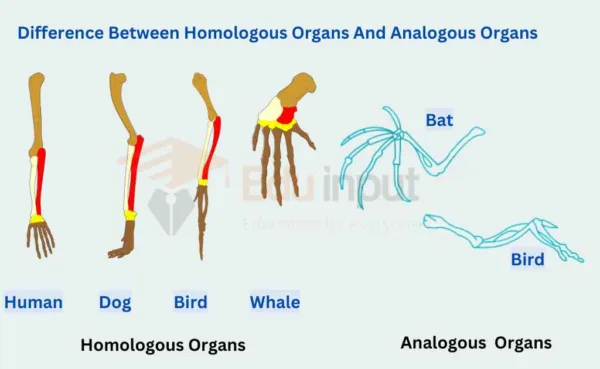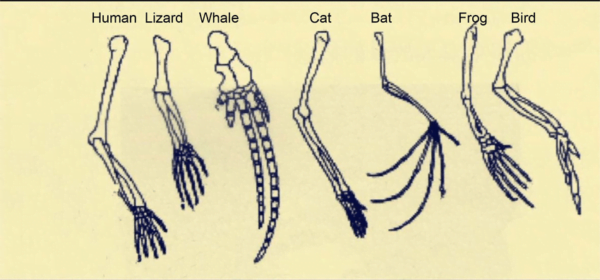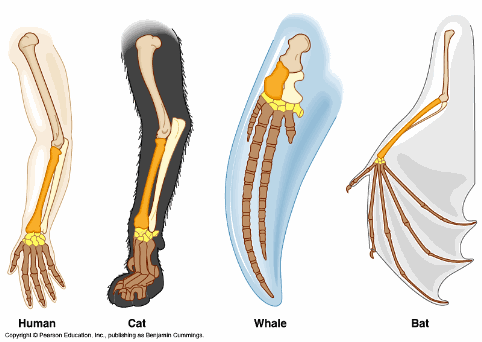In the diverse tapestry of life, we find fascinating similarities between parts of different animals, even when they aren’t closely related. Analogous and Homologous Organs will be described in detail in this article. These resemblances are known as ‘analogous’ organs, functioning similarly despite looking different. This occurs because these animals adapted in similar ways to their surroundings.
Conversely, other animals have parts that look and function similarly due to shared ancestry. These parts are called ‘homologous’ organs, revealing how animals are interconnected and have changed over time.
This article explores the study of analogous and homologous organs. We’ll delve into their functions, significance, and captivating examples from nature, illustrating how animals have adapted and evolved.

What are Analogous organs?
Analogous organs are biological structures found in different animal species, showcasing diverse anatomical forms yet serving comparable functions. These organs emerge due to convergent evolution, as unrelated organisms independently develop similar adaptations to thrive in comparable environments. Unlike homologous organs, which share common evolutionary origins, analogous organs have distinct ancestral backgrounds. They demonstrate the remarkable adaptability of life forms and the convergence of traits in response to shared ecological demands. Examples include the wings of birds and insects, highlighting how different species can evolve analogous solutions for survival and function.

Characteristics of Analogous Organs
- Diverse Anatomy, Similar Function: Analogous organs have varying anatomical structures in different animal species, yet they perform similar functions or have analogous physiological roles. This leads to functional parallelism despite structural differences.
- Convergent Evolution: Analogous organs result from convergent evolution, where unrelated organisms independently develop similar adaptations in response to comparable environmental pressures. This enables them to thrive in their specific habitats.
- Distinct Ancestry: Unlike homologous organs with shared evolutionary origins, analogous organs have diverse ancestral backgrounds. They evolve separately within distinct lineages, driven by the demand for comparable functionality.
- Ecological Niche: Analogous organs often arise when separate species inhabit the same or similar ecological niches. These niches necessitate specific survival adaptations, fostering the emergence of analogous structures.
- Common Functionality: Analogous organs share a primary trait—they perform similar functions or serve equivalent purposes across different species. This functional resemblance arises from parallel evolution, not shared ancestry.
- Superficial Similarity: While analogous organs may superficially resemble each other in terms of appearance, behavior, or function, a closer examination exposes internal structural differences.
- Diverse Origins: Despite comparable functions, analogous organs can have diverse origins, encompassing genetic composition, embryonic development, and underlying anatomical frameworks.
- Convergence in Traits: Analogous organs epitomize convergent traits. This convergence manifests when disparate organisms autonomously evolve similar traits due to analogous selective pressures.
- Numerous Examples: A plethora of instances showcasing analogous organs exists in the natural world. These include the wings of birds and insects, flippers of dolphins and penguins, and eyes adapted to underwater environments across different species.
- Functional Adaptation: Analogous organs exemplify life forms’ remarkable adaptability to diverse environments. They underscore the principle that natural selection propels the development of akin solutions to challenges posed by a shared environment, even in unrelated organisms.
Examples of Analogous Organs
Some examples of analogous organs are as follows:
- Birds and Insects Flying: Birds and insects have each evolved wings separately for flight, even though their wing structures and origins differ.
- Dolphins and Penguins Swimming: In aquatic settings, dolphins and penguins have developed flippers independently to navigate and swim, despite their separate lineage.
- Octopuses and Vertebrates Seeing: Octopuses and vertebrates possess camera-like eyes that grant them sight, even though their eye structures and origins exhibit variations.
- Bats and Dolphins Echolocating: Both bats and dolphins have independently acquired echolocation capabilities for navigating and hunting, despite their distinct evolutionary paths.
- Snakes and Insects Mimicking: Certain snakes and insects have evolved akin patterns and colors for camouflage or warnings, even though they belong to diverse categories.
- Legumes and Actinorhizal Plants Nutrient Absorption: Legumes and specific actinorhizal plants have separately developed root nodules housing nitrogen-fixing bacteria, facilitating nutrient absorption.
- Fish and Aquatic Insects Extracting Oxygen: Fish and aquatic insects have evolved gills individually to draw oxygen from water, adapting to their underwater habitats.
- Cacti and Euphorbias Protecting: Both cacti and euphorbias have developed thorns as protective measures, despite differing origins as plant species.
- Chameleons, Frogs, and Insects Camouflaging: Diverse creatures like chameleons, certain frogs, and specific insects have crafted comparable camouflage tactics to blend with surroundings.
- Cows and Kangaroos Digestive Adaptations: Herbivorous animals like cows and kangaroos have separately evolved similar digestive adaptations (such as multi-chambered stomachs) to process resilient plant material.
What are Homologous Organs?
Homologous organs are biological structures found in different species, sharing similar anatomical forms and often serving comparable functions. These organs stem from divergent evolution, as related organisms inherit common features from a shared ancestor. Unlike analogous organs, which have different origins, homologous organs have a common evolutionary background. They provide insights into the evolutionary relationships among species and reveal how traits have been passed down through generations. Examples include the forelimbs of vertebrates, demonstrating how underlying structures remain consistent despite variations in function.

Characteristics of Homologous Organs
- Shared Ancestry, Similar Structure: Homologous organs have comparable structures in different species due to a shared evolutionary origin. This leads to structural resemblance despite functional diversity.
- Divergent Evolution: Homologous organs arise from divergent evolution, where related organisms evolve unique adaptations over time, resulting in variations of a common structure.
- Common Developmental Pathways: Homologous organs often follow similar developmental pathways during embryogenesis, reflecting their shared ancestry.
- Functional Diversity: While homologous organs may perform different functions in various species, their fundamental structure and origin remain homologous.
- Inherited Traits: Homologous organs provide evidence of traits passed down from a common ancestor, aiding in the study of evolutionary relationships.
- Underlying Unity: Despite differences in appearance or function, homologous organs reveal a fundamental unity of life and the underlying genetic and developmental principles.
- Variation with Modification: Homologous organs exemplify Charles Darwin’s principle of “descent with modification,” where traits change over generations to adapt to different environments.
- Evolutionary Clues: Studying homologous organs helps scientists trace the evolutionary history of species and understand how adaptations have occurred over time.
- Adaptive Radiation: Homologous structures can undergo adaptive radiation, where they diversify to suit various ecological niches within related species.
- Phylogenetic Insight: Homologous organs are vital for constructing phylogenetic trees, which depict the evolutionary relationships among different species.
Examples of Homologous Organs
Here are some examples of homologous organs:
- Forelimbs of Vertebrates: The forelimbs of mammals, reptiles, birds, and amphibians share a common skeletal structure, adapted for diverse functions such as walking, flying, and swimming.
- Pentadactyl Limbs: The pentadactyl limb pattern, characterized by five digits, is found in various vertebrates, including humans, whales, bats, and horses.
- Vertebral Columns: The vertebral columns of vertebrates, though modified for different movements, exhibit a common structural arrangement of vertebrae.
- Homologous Genes: Genes with homologous sequences, such as the Hox genes, play crucial roles in embryonic development across diverse species.
- Homologous Proteins: Proteins like hemoglobin, with homologous amino acid sequences, serve analogous functions in oxygen transport across species.
Differences between Analogous and Homologous organs
This table outlines various parameters and aspects that differentiate homologous and analogous structures. Homologous structures share anatomical features due to shared ancestry, even if their functions differ. Analogous structures have similar functions but may not share evolutionary origins, often evolving independently in response to similar environmental pressures.
| Parameter/Aspect | Homologous Structure | Analogous Structure |
| Anatomy | Shows similar anatomy | Shows dissimilar anatomy |
| Function | Has dissimilar functions | Has similar functions |
| Inheritance | Inherited from a common ancestor | Not inherited from ancestors |
| Species Development | Develops in related species | Develops in unrelated species |
| Evolutionary Process | Result of divergent evolution | Result of convergent evolution |
| Environmental Adaptation | Adaptation to different environments | Adaptation to similar environments |
| Examples | Human arm, dog leg, whale flipper | Bird, bat, insect wings; fish fins |
| Ancestral Origin | Derives from common ancestor/origin | May not have common ancestry but similar function |
| Development Pattern | Have similar development patterns | May have dissimilar development patterns |
| Functional Correspondence | Function may differ due to evolution path | Function is similar despite different evolutionary origin |
| Evolutionary Relationship | Demonstrates shared evolutionary history | Represents convergence in evolution |
| Common Lineage | Traceable through common lineage | No shared evolutionary origin |
| Structural Similarities | Similar structural elements | Possible variation in structural elements |
References
- Byju’s. What are analogous organs
- Studious Guy. Analogous organs: Definition & examples
- Unacademy. Analogous organs.
- Vedantu. Distinguish between homologous and analogous.
- Biology Online. Analogous structures.
- Biology Discussion. Homology and Analogy of Organs in Plants.
Learn more